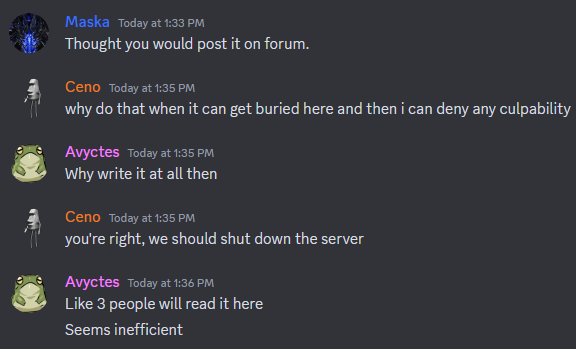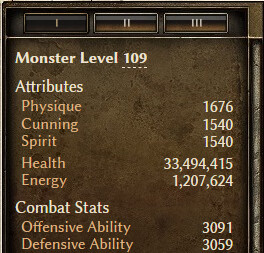
Well, fine. Here, get @'d nerd @Avyctes
This is a port of a document I wrote for a Discord conversation discussing Mutators and some suggested changes/wishes for changes to the system.
Unlucky.
Disclaimer: I am not a gamedev. I’m just some (m)asshole on the internet that plays too many different things.
On Mutators: First introduced in Crucible and then teased for the campaign in Discord before being outlined in Grim Misadventures #143, Mutators are Grim Dawn’s implementation of randomized map effects (called ‘map mod(ifier)s’ in Path of Exile/Last Epoch). The impetus for the creation of such a game feature stems from providing some form of continued interest in repeating what would otherwise be relatively-stagnant content at little development cost compared to adding MOAR content of greater substance. Randomized effects, randomized stat changes, etc.
Unfortunately, Grim Dawn’s mutators leave much to be desired. The sum of all mutators amounts to some (numerically minor) stat changes, and there is no scenario in which all such changes would be present at once. Moreover, the possibility exists that some combinations of mutators may counteract each other, resulting in little (if any) tangible gameplay impact. Worse still, while the numbers involved may appear minor, there are many mutators that result in a negative gameplay experience for players, to the point of resulting in ignored content. Perhaps worst of all, the current psychology developed to play around mutators usually tends toward ‘farming’ sessions/runs of an area until the following conditions are met:
- Zero consequently negative player-affecting mutators are present
- Zero consequently positive monster-affecting mutators are present
- Zero or more positive player-affecting mutators are present
This results in a scenario where not only are players rerolling content away from modifiers that may harm their runs, they are also complacent with neutral mutators that incur no substantial effect to their gameplay whatsoever.
Before we continue, there is one ‘rule of thumb’ I would like to posit that, if you and I do not agree to, there really isn’t much point in you reading further:
- Any content the vast majority of players willingly ignore is content that should not have development hours poured into.
Put another way,
- Any content the vast majority of players willingly ignore is content that should not be designed in the first place.
If you find yourself agreeing with this sentiment, we can move on together.
It is the role of a game designer to guess at what their audience will engage with. A designer may not always be correct—and that is fine!—but the target goal being of the pursuit of engaging content is the designer’s quarry. To that end, we find that the target goal of mutators has been catastrophically not met. Rather than resulting in the continued engagement of content, mutators discourage gameplay more often than some acceptance of their presence is found.
At this point I should note the common adage that video game players are great at identifying problems with game systems but horrendous at proposing solutions. So before pointing out further issues with GD’s system and comparing it to the systems of other games (which may also be flawed), I want to take a moment to suggest my solution now:
Only have positive player-affecting mutators in the pool, but scale enemy difficulty based on the number of mutators applied to players.
To elaborate on the above suggestion, I do first need to pivot to the situation in another game: Destiny (2), which (for reasons unrelated) I no longer play, but have invested comparable hours into relative to Grim Dawn. Destiny 2 features Nightfalls, which are PvE instanced content with modifiers on them that rotate on a weekly basis. While technically more modifiers themselves do not equate to better rewards, the quantity of modifiers is given by the difficulty of the Nightfall chosen, and the rewards are dictated by that difficulty.
Unfortunately, Destiny 2 is also plagued by Nightfall weeks that are often skipped by all but the most ardent challenge-seekers of the game when particularly painful modifier combinations are established on more challenging Nightfalls. Things like “players taken more damage when in the air” (the ‘Grounded’ modifier) is a near-death sentence in a high-mobility first person shooter. More subtle modifiers, such as “enemies deal 25% more Arc damage” can remain extremely punishing in Arc-heavy Nightfalls or those with an Arc-dealing endboss.
Meanwhile, however, Destiny 2 is on the cusp of greatness with certain modifiers that encourage buildcrafting. Things like “Players deal 50% more Void damage” and “Players take less damage while moving” can encourage high-mobility Void builds, of which void is, traditionally, a ‘stand your ground’ sort of damage type. These modifiers encourage players to theorycraft and put new builds together, which can mean farming more content to acquire the resources for those builds. However, the modifiers which amplify enemies and debuff players do not encourage further engagement, rather discouraging any engagement at all.
This scenario is hardly unique to Destiny 2. Many other games run into similar scenarios where some of their endgame randomized systems invite player creativity and approaches to those systems while simultaneously stifling player interest.
Unfortunately for Grim Dawn, and most ARPGs in general, the idea of ‘buildcrafting’ on the fly to tackle a new challenge isn’t particularly viable. Not only are Grim Dawn’s challenges less persistent (in that they do not last a week, they instead only last a session before returning to the main menu), but changing character builds is antithetical to the idea of most ARPGs, Grim Dawn included, where ‘maxing’ the strength of a single build on a single character is often the name of the game. The cost of ‘respeccing’, in both in-game resources and in time, is often much, much larger than that in games of other genres—on the scale of time, where one may change builds in Destiny 2 in a matter of minutes, in Grim Dawn it could take hundreds of hours if it was possible at all, given Grim Dawn’s prohibition of total in-game class respecs.
So what, then, are we left with?
Per the above suggestion, in bold, we can limit the pool of mutators to some powerful player-affecting positive modifiers that at worst players cannot make advantage of with their build and at best can lean heavily into for a more engaging experience. Moreover, we can scale enemy difficulty by introducing a system where enemies get innately stronger for each additional Mutator applied to players—perhaps they gain ten levels per mutator, as an example. In Grim Dawn, monster levels equate to more damage on their skills, more OA and DA in their statblock, and more Health for players to chunk through. This is an anticipated, known scaling factor across all enemies in the game, and presents a choice for players: do they want to roll for a good Mutator that will amp their damage but risk getting something useless to them that consequently also improves enemy statlines?
This, then, also allows for other opportunities of engagement. Perhaps in Crucible a system could be in place to talk to Lokarr, spend some tributes, and get a random Mutator at the cost of increasing enemy levels. The deeper on goes in the Shattered Realms, the more Mutators one receives, and the higher enemy levels grow. And dangerous domains may become, at last, a bit more dangerous. Giving players the choice to take on additional Mutators is a powerful one—most choices are, after all.
One game that does a system like this very well is Vermintide 2. Vermintide 2 has overwhelmingly more positive player-affecting modifiers in its Chaos Wastes gamemode than modifiers which harm players or empower enemies, and those which harm players/empower enemies are usually of a more interactive sort. For instance, a harmful player modifier spawns intangible blood tornadoes that wander the map, keeping players on their toes, while an empowering enemy modifier makes enemies ‘split’ into lesser foes when slain, keeping players in the thick of combat. These are welcome ideas for Grim Dawn, but for the sake of simplicity, I think the easiest ‘fix’ to Mutators does not involve the introduction of new gameplay mechanics such as these.
I would love to see it though.
That’s basically the sum of my feedback specific to Grim Dawn, but I do want to take a moment while we’re here to discuss some specific modifiers I’ve seen in gaming, many of which have left a very positive or negative taste in my mouth after experiencing.
-
Enemies drop X pool of damage on death. / Enemies buff their nearby allies on death. / Enemies debuff nearby players on death. I see this a lot (particularly in ARPGs like Grim Dawn/Path of Exile/Last Epoch/Diablo) and I’ve always loathed it. It creates a scenario where players want to avoid killing anything more than they need to. Or, rather, players want to avoid content. And what was that rule of thumb we agreed to up above?
-
Enemies [punish you for playing a certain damage type]. See above. Maybe it’s punishment in the form of being more resistant to that damage type, or maybe they reflect a certain amount of that damage type back to players. Either way, it discourages interaction at best and at worst results in avoidance. Again, rule of thumb.
-
Enemies spawn more enemies on death. This is a great modifier. In any game where we’re going around killing mobs as part of a main gameplay loop, having more things to kill is never a bad thing, especially when it comes as consequence of engaging with the loop in the first place. A positive implementation of an enemy buffing mechanic.
-
Players have a chance to [do something] on [attack/kill/etc.]. Great modifier. In Vermintide, this might be chain lightning on attack, which is one of the best modifiers one can find and also among the most satisfying. In other games, this could be releasing a burst of freezing cold upon slaying a foe, or dropping meteors from the sky when critting their opponent. Whatever the case, it usually looks cool, feels cool, and in an ARPG with damage types, can be leaned into and exploited by the right builds, adding a luck factor on top of it all. “Gee, I really hope my Primal Strike build gets that chain lightning modifier!”
-
Enemies have a chance to slow you on hit. This is a Last Epoch modifier, and it is my most detested one. Refer to the rule of thumb. The problem with this modifier is that it elongates the period of time between action sequences. We spend a lot of time in these sorts of games, be they first person shooters or horde slashers, or ARPGs, moving from one place to another. Having that period of time extended is never a good thing.


